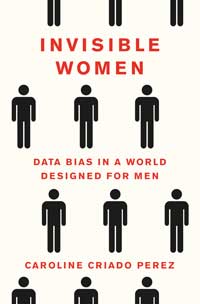Invisible Women: Data Bias in a World Designed for Men

Caroline Criado Perez
Abrams Books,
New York, 2019, 432 pp., $27.00
“The gender data gap isn’t just about silence. These silences, these gaps have consequences.”
This is what Caroline Criado Perez tries to drive home in her book Invisible Women.
Criado Perez emphasizes that the “male unless indicated otherwise” approach to all aspects of life and the myth of “male universality” are not malicious or even deliberate, but are the product of thinking that has been around for millennia.
She provides numerous examples—some well known and others less so—of biases against women, including the 2013 homage to tennis player Andy Murray as the first Briton to win Wimbledon, when in fact Virginia Wade had won in the tournament more than three decades earlier in 1977.
The book’s most compelling passages discuss the consequences of the absence of sex-disaggregated data. She describes the snow-clearing schedule in the town of Karlskoga, Sweden, where the major traffic arteries are plowed first and pedestrian walkways and bicycle paths are cleared last. Why is this sexist? Men tend to work outside their homes and travel to work in cars or buses, while women are far more likely to walk with a child to school, sometimes wheeling other children in strollers. A seemingly innocuous snow-clearing schedule, together with the disproportionate burden of caregiving that falls on women, puts women in a double bind. Other examples are even more insidious—the health risks to women caused by a failure to provide public toilet facilities or the life-and-death consequences, for example, of scant sex-disaggregated data in medical research when it comes to the different symptoms of heart attacks in men and women.
Criado Perez provides eye-opening examples of the biases in the design of common, apparently gender-neutral, products used in everyday life and the ramifications of the “one-size-fits-men” approach. Take safety equipment in automobiles—headrests, seatbelts, and airbags. Crash test dummies are designed around a 50th percentile male, about 1.77 meters tall and weighing 76 kilograms. The fact that the safety equipment does not take into account that women are, on average, shorter and lighter contributes to the shocking statistic that when a woman is involved in a car crash, she is 47 percent more likely to be seriously injured than a man and 17 percent more likely to die! And all because we have failed to factor in gender differences when designing the safety equipment in cars.
Criado Perez also covers ground that is more familiar to economists—including the failure to properly measure unpaid household and care work, the impact of taxes on women’s choice to join the labor force, and the disproportionate representation of women among the world’s poor.
Criado Perez concedes that closing the gender data gap will not magically fix all the problems women face. She concludes, however, that closing the gender data gap will happen only once the gap in female representation in leadership and government is bridged.
This impressive book is a must-read for any researcher and policymaker who is serious about addressing the challenges faced by half the world’s population.
Opinions expressed in articles and other materials are those of the authors; they do not necessarily reflect IMF policy.









